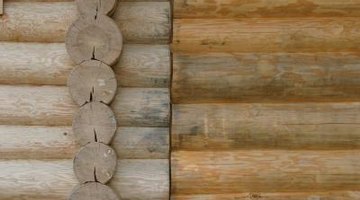How to Use Yellow Poplar Logs for Building
The tall and straight yellow poplar trees commonly grow east of the Mississippi River. Yellow poplars are also known as a tuliptrees because of their tulip-shaped leaves and blossoms. Yellow poplar trees are not related to other types of poplars. They are in the magnolia family. Yellow poplars grow to 100 feet or more with a trunk diameter of 2 to 5 feet. The lateral branches start at approximately two-thirds the height of the tree, so the wood is relatively knot free. Yellow poplar wood is a lightweight, low-density type of hardwood that is moderately strong.

Step 1
Build a log cabin with yellow poplar logs if the design includes a large roof overhang. The logs have a short life expectancy under moist conditions, unless they are treated with a wood preservative and protected from rain. Years ago, old growth or virgin yellow poplar timber was used for log cabin construction. However, the wood from yellow poplar species produced today often has very little resistance to boring insects and fungi that cause decay.
Step 2
Cut yellow poplar trees into 2-inch-by-4-inch or larger boards for a variety of uses. Yellow poplar boards dry easily without excessive warping and twisting. Use the boards as structural components for building houses, barns and sheds. The boards rarely split during nailing, but the wood is only rated as fair for its screw- and nail-holding ability. Use care when handling the wood because it dents and mars easily.
Step 3
Construct the hidden interior frames of furniture from yellow poplar. Use the wood for building door frames, doors, shelving, boxes and crates. Consider using yellow poplar moldings and trims for building projects. Yellow poplar boards and trim are easy to glue. They are excellent for staining and painting. Cherry-stained yellow poplar looks very similar to more expensive cherry wood.
Step 4
Cut yellow poplar logs into siding for houses and barns. It is also a useful wood for fence boards. Yellow poplar produces a short-fibered pulp that is made into insulating boards and particleboard. The wood is used as veneer for hardwood plywood.
References
Tips
- Yellow poplar wood is also used for carving and making woodenware.
Writer Bio
Kim Dieter has taught agriscience classes, developed curriculum and participated in the school accreditation process at the secondary and community college levels since 1980. She holds a Master of Science degree from the University of California, Davis, in animal science.
Photo Credits
- Jupiterimages/Photos.com/Getty Images
More Articles



